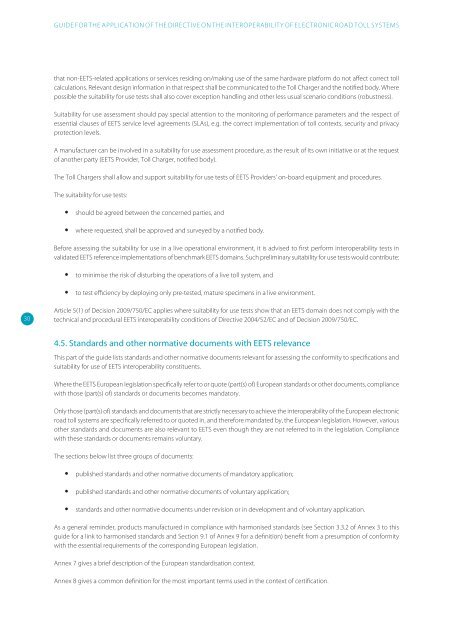The European Electronic Toll Service (EETS)
The European Electronic Toll Service (EETS) - ITS Hungary Egyesület
The European Electronic Toll Service (EETS) - ITS Hungary Egyesület
- No tags were found...
You also want an ePaper? Increase the reach of your titles
YUMPU automatically turns print PDFs into web optimized ePapers that Google loves.
GUIDE FOR THE APPLICATION OF THE DIRECTIVE ON THE INTEROPERABILITY OF ELECTRONIC ROAD TOLL SYSTEMS<br />
that non-<strong>EETS</strong>-related applications or services residing on/making use of the same hardware platform do not affect correct toll<br />
calculations. Relevant design information in that respect shall be communicated to the <strong>Toll</strong> Charger and the notified body. Where<br />
possible the suitability for use tests shall also cover exception handling and other less usual scenario conditions (robustness).<br />
Suitability for use assessment should pay special attention to the monitoring of performance parameters and the respect of<br />
essential clauses of <strong>EETS</strong> service level agreements (SLAs), e.g. the correct implementation of toll contexts, security and privacy<br />
protection levels.<br />
A manufacturer can be involved in a suitability for use assessment procedure, as the result of its own initiative or at the request<br />
of another party (<strong>EETS</strong> Provider, <strong>Toll</strong> Charger, notified body).<br />
<strong>The</strong> <strong>Toll</strong> Chargers shall allow and support suitability for use tests of <strong>EETS</strong> Providers’ on-board equipment and procedures.<br />
<strong>The</strong> suitability for use tests:<br />
• should be agreed between the concerned parties, and<br />
• where requested, shall be approved and surveyed by a notified body.<br />
Before assessing the suitability for use in a live operational environment, it is advised to first perform interoperability tests in<br />
validated <strong>EETS</strong> reference implementations of benchmark <strong>EETS</strong> domains. Such preliminary suitability for use tests would contribute:<br />
• to minimise the risk of disturbing the operations of a live toll system, and<br />
• to test efficiency by deploying only pre-tested, mature specimens in a live environment.<br />
30<br />
Article 5(1) of Decision 2009/750/EC applies where suitability for use tests show that an <strong>EETS</strong> domain does not comply with the<br />
technical and procedural <strong>EETS</strong> interoperability conditions of Directive 2004/52/EC and of Decision 2009/750/EC.<br />
4.5. Standards and other normative documents with <strong>EETS</strong> relevance<br />
This part of the guide lists standards and other normative documents relevant for assessing the conformity to specifications and<br />
suitability for use of <strong>EETS</strong> interoperability constituents.<br />
Where the <strong>EETS</strong> <strong>European</strong> legislation specifically refer to or quote (part(s) of) <strong>European</strong> standards or other documents, compliance<br />
with those (part(s) of) standards or documents becomes mandatory.<br />
Only those (part(s) of) standards and documents that are strictly necessary to achieve the interoperability of the <strong>European</strong> electronic<br />
road toll systems are specifically referred to or quoted in, and therefore mandated by, the <strong>European</strong> legislation. However, various<br />
other standards and documents are also relevant to <strong>EETS</strong> even though they are not referred to in the legislation. Compliance<br />
with these standards or documents remains voluntary.<br />
<strong>The</strong> sections below list three groups of documents:<br />
• published standards and other normative documents of mandatory application;<br />
• published standards and other normative documents of voluntary application;<br />
• standards and other normative documents under revision or in development and of voluntary application.<br />
As a general reminder, products manufactured in compliance with harmonised standards (see Section 3.3.2 of Annex 3 to this<br />
guide for a link to harmonised standards and Section 9.1 of Annex 9 for a definition) benefit from a presumption of conformity<br />
with the essential requirements of the corresponding <strong>European</strong> legislation.<br />
Annex 7 gives a brief description of the <strong>European</strong> standardisation context.<br />
Annex 8 gives a common definition for the most important terms used in the context of certification.



